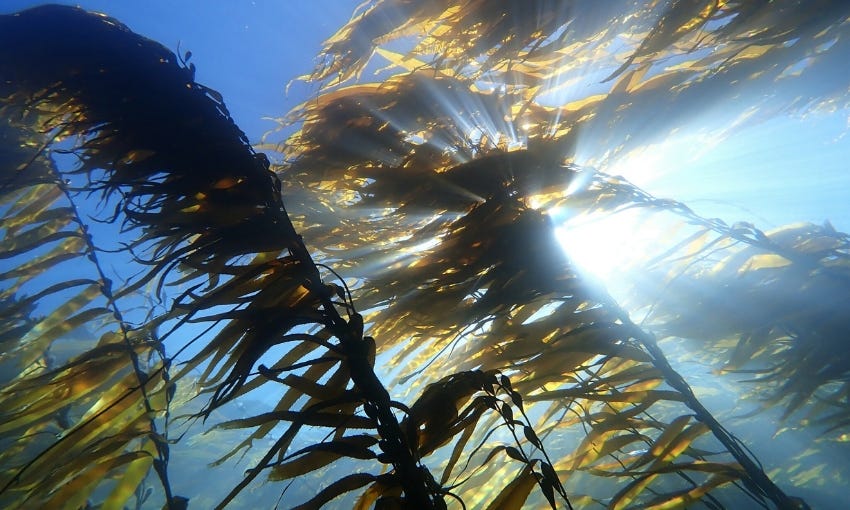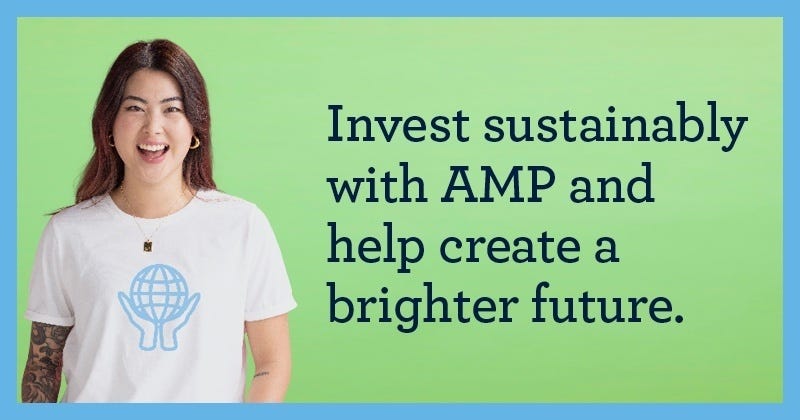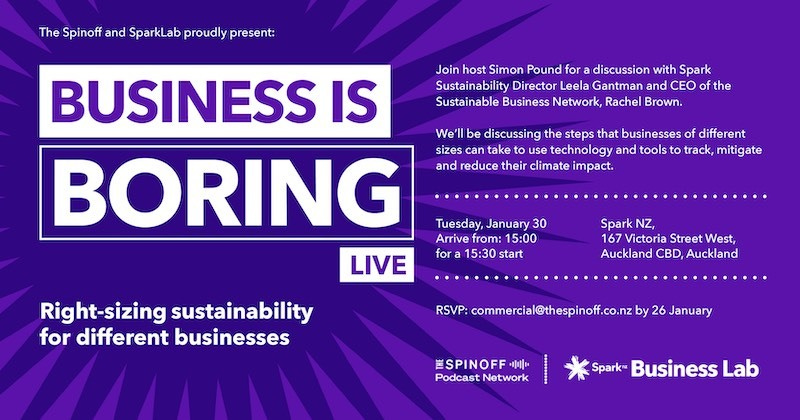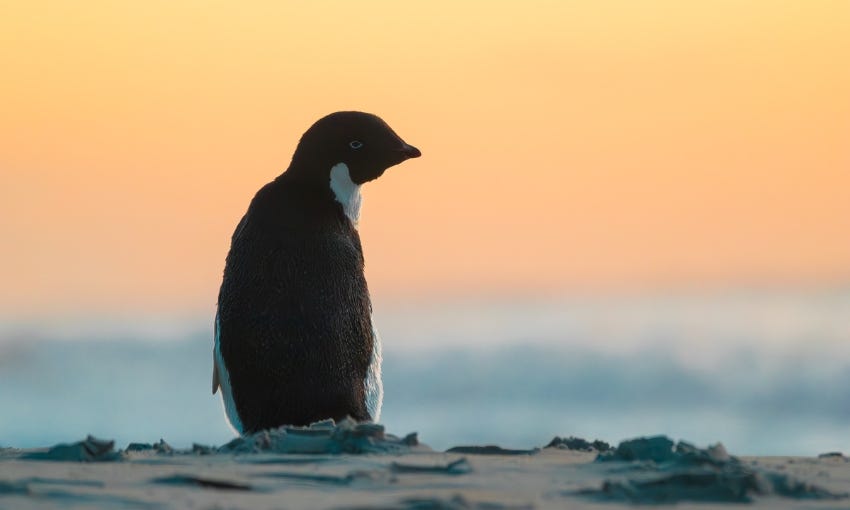A kelping hand for Aotearoa’s forgotten forests
Beneath the waves, kelp forests are disappearing. Can we bring these climate superheroes back?
Kia ora, welcome to Future Proof brought to you by AMP. I’m Ellen, thanks for joining me this week.
Giant kelp (Macrocystis pyrifera). Image credit: Luca Davenport-Thomas via iNaturalist NZ (CC BY-NC 4.0).
“When you start to look really closely, it’s really beautiful. When you start to notice it all,” says Zoe Studd, executive director of Mountains to Sea Wellington. “They're just as important as our forests on land. It's just that we don't get to interact with them as much.”
Studd is waxing lyrical about seaweed. Perhaps seaweed makes you think of sushi. Or maybe something unwelcome touching your foot in the surf at the beach. “How do we get people to care about this seaweed thing that people often find quite creepy?” she wonders. “We’ve got a PR campaign to run here.”
That PR campaign takes the form of Love Rimurimu, a Wellington-based project covering “every aspect of seaweed nerdery”. It connects communities with our lush, underwater kelp forests through activities like guided snorkel days, and is also helping to figure out how we might be able to restore this ecosystem.
Around New Zealand – and indeed globally – kelp forests are disappearing. Sedimentation darkens coastal waters, smothering seaweed. Kelp is munched into oblivion by an overabundance of grazers like kina, whose population explodes when we humans fish out too many big snapper and crayfish that usually keep their numbers in check. And of course climate change is heating up the oceans too.
In 2021, the folks at Love Rimurimu asked the rangatahi at Te Kura Kaupapa Māori o Ngā Mokopuna on the Miramar Peninsula Motu Kairangi: if you were going to do restoration, where might you do it? After examining temperature, sedimentation, and even old place names, the “Kura Kelpers” presented a restoration plan to mana whenua Taranaki Whānui, and the project scored a five-year resource consent to replant and experiment.
Kura kelper with seaweed-inoculated rocks, aka “green gravel” ready for planting out. Image credit: Love Rimurimu.
This past September, the first giant kelp (Macrocystis pyrifera) babies returned to the waters of Worser Bay. Rocks inoculated with seaweed spores were grown in an aquaculture facility at NIWA, Studd explains. First, the rocks develop a brown fuzz. Then the baby kelp grow a holdfast – the structure that clings to the rock – as well as a stem (called a stipe) and a single blade. “They’re super cute,” says Studd. “We try and get them to about five centimetres before we plant them out.”
After karakia and waiata, rangatahi freedivers swam out to place the seaweed-laden “green gravel” into restoration plots, which continue to be intensively monitored. “Rachel, who runs our community science monitoring staff, she knows all the rocks. She knows all the seaweed intimately,” says Studd. The restored kelp plants now number 300, and some have already grown to over 60cm long. But the process has come with challenges.
“We’ve had an octopus come through and push over our rocks. We've watched a fish eat our seaweed,” says Studd. The team aren’t managing grazers like kina, but are open to learning and adapting their approach if it means successfully bringing back kelp.
There’s good reason to restore these lost forests. Kelp absorbs carbon – up to 52 tonnes per hectare per year, more than double that of pine trees, according to NIWA. It also improves water quality, reduces localised ocean acidification impacts, and buffers coastlines from destructive wave energy. Then there are the biodiversity benefits: “It’s a three-dimensional ecosystem that has habitat, shelter, a place for reproduction. And it’s a food source as well,” says Studd. “Everything relies on seaweed being there and being healthy.” Including us.
“That feeling you get when you’re floating over a seaweed forest for the first time, particularly in a marine reserve where it’s so lush, is transformative.”
Mountains to Sea Wellington is running free community snorkel days in Taputeranga Marine Reserve if you too would like to experience the magic of kelp forests.
AMP believes that investing in a sustainable future is the best way to achieve long-term investment success. That's why they integrate environmental, social, and governance (ESG) factors into all of their investment decisions.
AMP supports companies that are making a positive impact on the world while avoiding those that are causing harm. AMP is also working to reduce its own carbon footprint and achieve a net zero outcome by 2050 or sooner.
After 2023 brought the heat, what’s in store for 2024?
It’s official: 2023 was Aotearoa’s second hottest year on record, falling just shy of 2022’s record-breaking heat, according to NIWA. Globally, last year was the hottest year on record. “There were simply no cities, no books, agriculture or domesticated animals on this planet the last time the temperature was so high,” said Carlo Buontempo, director of the Copernicus climate change service. The Washington Post has an interactive game where you can guess just how crazy last year’s weather was. With El Niño now at its peak, 2024 could be the first full year to go beyond 1.5 °C of warming, the UK’s Met Office predicts.
Most of us are concerned about climate change
Almost 80% of New Zealanders believe in the reality of anthropogenic climate change and are concerned about it, a survey of nearly 35,000 people found. This belief and accompanying concern remained very stable over a year. In contrast, climate deniers made up just 3.7% of respondents. However, the socio-demographics of this group (more likely to be male, conservative and in favour of hierarchical social systems) mean they’re more likely to be in positions of power, the study authors say, “meaning that their denial can be extremely consequential in delaying action”.
The Spinoff and SparkLab proudly present: Business is Boring Live
Right-sizing sustainability for different businesses.Join host Simon Pound for a discussion with Spark Sustainability Director Leela Gantman and CEO of the Sustainable Business Network, Rachel Brown.
We'll be discussing the steps that businesses of different sizes can take to use technology and tools to track, mitigate and reduce their climate impact.
If you would like to join us, please RSVP: commercial@thespinoff.co.nz by the 26th January.
More stories
The world’s renewable energy capacity grew by 50% in 2023 – a record-breaking pace of change, says the International Energy Agency.
Data scientist Hannah Ritchie makes the argument for envisioning a liveable sustainable future, and not giving into climate doomism.
Why are our swim spots so polluted? Shanti Mathias investigates for The Spinoff. (Related: hot El Niño conditions are causing more potentially toxic algae blooms in lakes and rivers.)
Milk grown in a lab without animals and innovation in barn- and feedlot-based farming overseas could eat away at New Zealand’s position as a leader in clean and green dairy, writes Stuff’s Olivia Wannan.
I also took a look at the methane-busting efforts of New Zealand’s farming sector for BBC Future.
For every litre of bottled water you drink, you’re consuming hundreds of thousands of teeny bits of plastic, a new study finds.
Here’s how Paora the kiwi, resident at Zoo Miami in the US, is faring after the kiwi “petting” scandal.
In case of disaster: pack your memories into a “climate carry-on” alongside the necessities.
How to make your life greener in 2024.
The Spinoff is powered by its supporters
In 2023, Spinoff readers funded some of our most beloved, well-read and impactful work. Help Me Hera, The Cost of Being, powerful longreads, Election 2023 coverage, laugh out loud satire, Wellington stories, Christchurch stories and everything in between was powered by Spinoff members and donors. If you did support us, thank you from all of us at The Spinoff. If helping fund well-crafted and insightful journalism is on your list for 2024, donate today or sign up to become a Spinoff member.
Image credit: Alberto Roldán Sastre.
To finish this issue, an Adélie penguin turned up on St Clair beach in Ōtepoti Dunedin this week, a long way from its Antarctic home. The penguin has been escorted by the Department of Conservation to the Otago Peninsula Eco Restoration Alliance where it can rest up in peace. Before moving to this safer spot, the sighting delighted Alberto Roldán Sastre, who recently moved to Dunedin to study penguins and glimpsed the rare visitor on his birthday. These moments of connection with te taiao are one wish for the coming year from Forest & Bird chief executive Nicola Toki that resonated with me. Perhaps you’re more of a resolution person though – the Climate Club has suggestions for climate resolutions, or even big hairy audacious goals if that’s your jam!
More climate peng-wins in 2024 please,
Ellen
Got some feedback about Future Proof or topics you’d like covered? Get in touch with me at futureproof@thespinoff.co.nz














Anyone interested in kelp, should read about this: https://www.mossy.earth/projects/kelp-nursery. They have moved on from individually planting the rocks to simply tipping them over the side of the boat - and it seems to be successful! I hope the kura kelpers have heard of this project and are sharing information.
Bloody Aotearoa. New Zealand is where paradise is. The other place will become devoid of rational human beings when we get out before the place is destroyed.